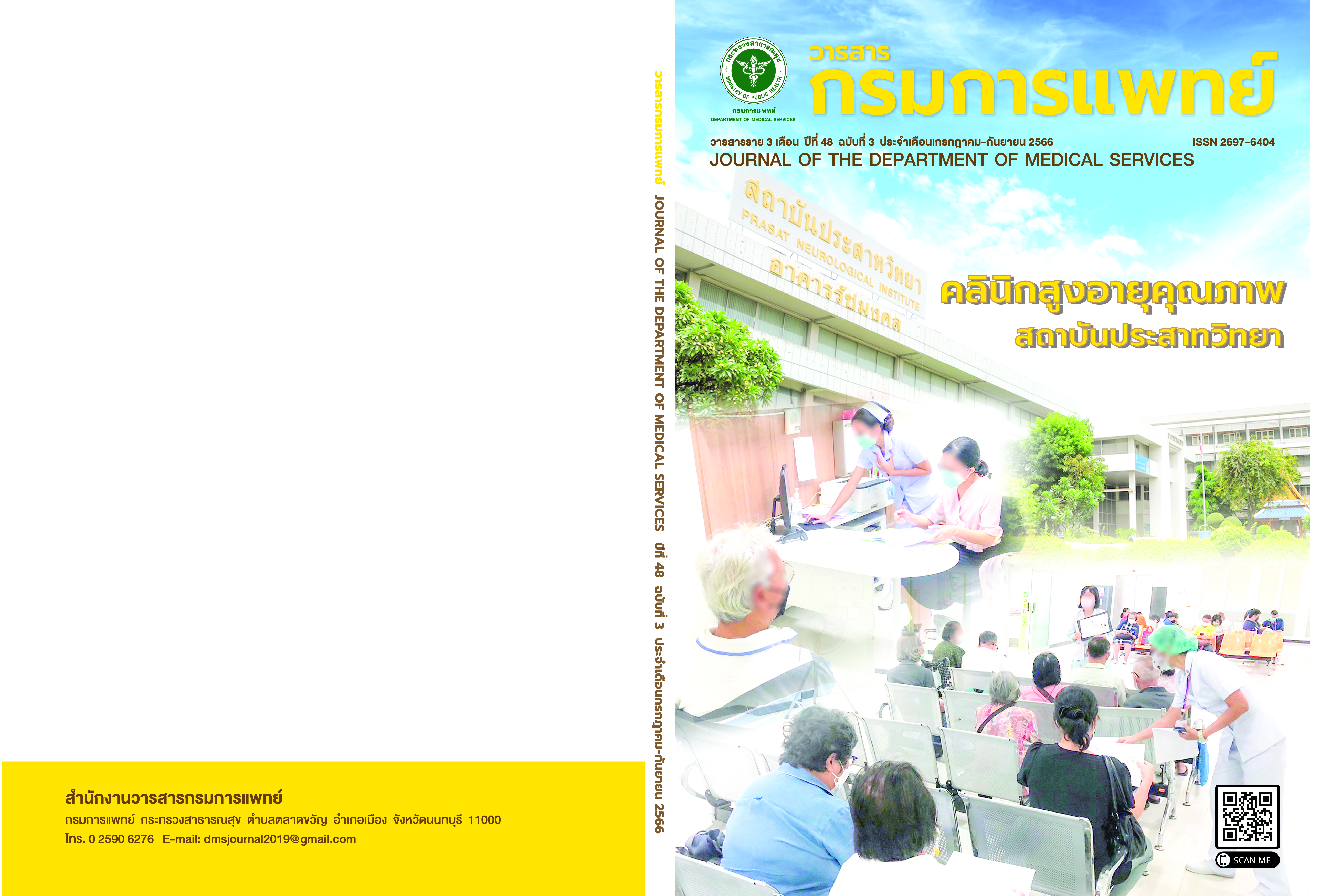Chlorogenic Acid and Biological Activity of Chrysanthemum indicum L. Extract at Various Geographical Locations in Thailand
Keywords:
Chrysanthemum indicum L., Chlorogenic acid, Biological activity, Antioxidant activityAbstract
Background: Chlorogenic acid (CGA) is a phenolic compound most found in coffee. It can be found in numerous types of tea plants, including Chrysanthemum. CGA has shown antioxidant and anticancer activities. Objective: To compare the contents of CGA, total phenolic, and total flavonoids in Chrysanthemum flower extractsfrom different planting sites in Thailand and to evaluate the biological activity for antioxidant and cytotoxicity against oral cancer cells. Method: The CGA, total phenolics, and total flavonoids were extracted and evaluatedfrom Chrysanthemum flower by using different solvents, ≥99.9% ethanol, 40% ethanol and water. The antioxidantand cytotoxic activities of the extracts were determined by using DPPH and MTT assays, respectively. Result: Thecontents of chemotypes from each planting source are different. The highest contents of CGA and total phenolics,1.41%w/w and 93 mg GAE/g, respectively were found in Chrysanthemum flowers from Chiang-Mai. Meanwhile,the highest contents of total flavonoids, 23 mg QE/g, were found in Chrysanthemum flowers from Samut Prakan.Chrysanthemum flowers from Samut Prakan showed the highest antioxidant activity (IC50 165.33 µg/mL), followingby Chrysanthemum flowers from Chiang-Mai (IC50 169.50 µg/mL), but there was no statistically significant difference(p ≥ .05). In addition, Chrysanthemum flower crude extract could not induce oral cancer cell death by more than50 %, so it was considered no cytotoxicity. Conclusion: The contents of CGA, total phenolics, and total flavonoidsin the crude extracts varied depending on the various geographical location and solvent. Thailand’s Chrysanthemumflower extracts show antioxidant activity but do not show cytotoxicity against oral cancer cells.
References
Ren ZH, Hu CY, He HR, Li YJ, Lyu J. Global and regional burdens of oral cancer from 1990 to 2017: Results from the global burden of disease study. Cancer Commun (Lond) 2020;40(2-3):81-92.
Gupta N, Gupta R, Acharya AK, Patthi B, Goud V, Reddy S, et al. Changing Trends in oral cancer - a global scenario. Nepal J Epidemiol 2016;6(4):613-9.
Arunpraphan S. The trends of oral cavity and pharyngeal cancer incidence in Thailand, 2004-2015. Th Dent PH J 2019;24:55-67.
Ram H, Sarkar J, Kumar H, Konwar R, Bhatt ML, Mohammad S. Oral cancer: risk factors and molecular pathogenesis. J Maxillofac Oral Surg 2011;10(2):132-7.
Poulopoulos A, Papadopoulos P, Andreadis D. Chemotherapy: oral side effects and dental interventions -a review of the literature. Stomatological Disease and Science 2017;1:35-49.
Hayakawa S, Ohishi T, Miyoshi N, Oishi Y, Nakamura Y, Isemura M. Anti-cancer effects of green tea epigallocatchin- 3-gallate and coffee chlorogenic acid. Molecules 2020; 25(19):4553.
Chiang HM, Chen CW, Chen CC, Wang HW, Jhang JH, Huang YH, et al. Chapter 58. Role of coffea arabica extract and related compounds in preventing photoaging and photodamage of the skin. In: Preedy VR, editor. Coffee in health and disease prevention. San Diego: Academic Press; 2015. p. 523-30.
Bhardwaj R. Cytotoxic role of chlorogenic acid on oral squamous cell carcinoma cell line. Indian Journal of Otolaryngology and Head & Neck Surgery 2021;74(2).
Zhan Y, Li R, Feng C, Li X, Huang S, Wang L, et al. Chlorogenic acid inhibits esophageal squamous cell carcinoma growth in vitro and in vivo by downregulating the expression of BMI1 and SOX2. Biomed Pharmacother 2020;121:109602.
Sun Ql, Hua Sy, Ye JH, Zheng X, Liang Y. Flavonoids and volatiles in Chrysanthemum morifolium Ramat flower from Tongxiang County in China. African Journal of Biotechnology 2010;9(25):3817-21.
Kulrath P, Duangdee N, Supornpun N, Prateeptongkum E. Comparison of Fluoride and Catechin levels in green tea extract at various geographical locations in Thailand. j dept med ser 2019;44(2):114-20.
Damasuri AR, Sholikhah EN, Mustofa. Cytotoxicity of ((E)-1- (4-aminophenyl)-3-phenylprop-2-en-1-one)) on HeLa cell line. Indonesian Journal of Pharmacology and Therapy 2020; 1(2):54-9.
Wang L, Pan X, Jiang L, Chu Y, Gao S, Jiang X, et al. The biological activity mechanism of Chlorogenic acid and its applications in food industry: A Review. Front Nutr 2022; 9:943911.
Sharma G, Kamboj M, Narwal A, Bhardwaj R, Yadav P. Cytotoxic role of Chlorogenic acid on oral squamous cell Carcinoma cell line. Indian J Otolaryngol Head Neck Surg 2022;74(Suppl 3): 5773-81.
Downloads
Published
How to Cite
Issue
Section
License
Copyright (c) 2023 Department of Medical Services, Ministry of Public Health

This work is licensed under a Creative Commons Attribution-NonCommercial-NoDerivatives 4.0 International License.
บทความที่ได้รับการตีพิมพ์เป็นลิขสิทธิ์ของกรมการแพทย์ กระทรวงสาธารณสุข
ข้อความและข้อคิดเห็นต่างๆ เป็นของผู้เขียนบทความ ไม่ใช่ความเห็นของกองบรรณาธิการหรือของวารสารกรมการแพทย์



